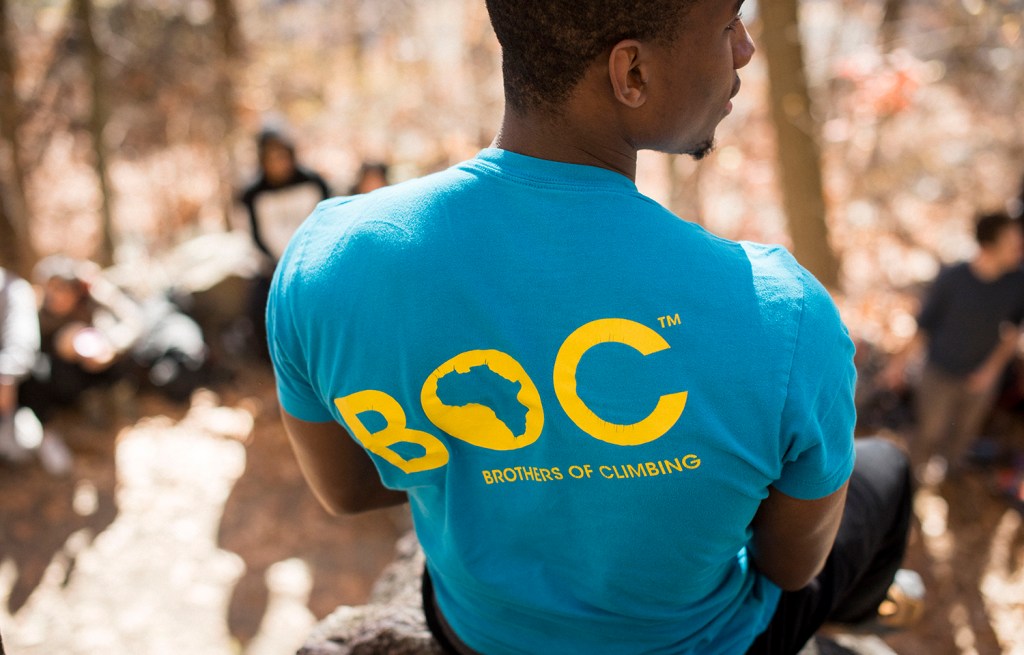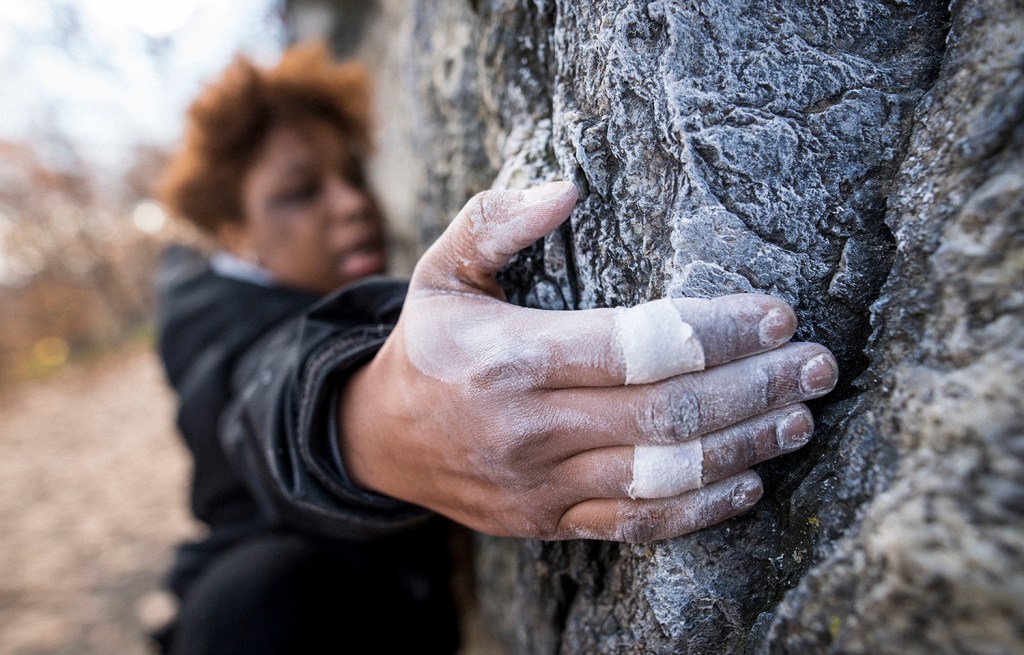Brothers of Climbing, based in Brooklyn, New York, is an organization that seeks to make the rock climbing community more diverse. Everyone benefits from inclusion, representation and a more welcoming community. We sat down with co-founder Mikhail Martin to discuss how BOC got started and where it is going. Join us for the discussion.
How did Brothers of Climbing begin?
That’s a long story. When we first started climbing at Brooklyn Boulders in New York back in 2009 there were so few black climbers. When you came across another you would make it your duty to introduce yourself. I was a pretty bad climber—no technique and no strength—but that is how I met Andrew Belletty, known as Drew. He was more experienced and just way stronger, but he would always try to help me and my friends that I started climbing with. Drew and I started climbing together more often and that is when we met David Glace, also known as Glache. Even though our climbing circle grew larger, there were still so few black climbers that somewhere along the way we would joke and call ourselves BOC (Brothers of Climbing). It began to stick.
We always had a good time climbing and the energy was contagious. People would migrate from other parts of the gym to come laugh around with us. Drew, Glache and I had the idea that we could share this energy—we wanted to see more people like us enjoying the sport and benefiting from the great community. That was when we decided to start Brothers of Climbing, Inc. Drew worked tirelessly to design the logo and we started spreading the word.
What does the energy of the group feel like?
It’s hard to describe in words what the group’s energy feels like. The group is just too fun to be around. Laughter is one core component, yet we take our climbing seriously and push each other to climb harder. Everybody wins: You get strong and have fun. There is so much support within the crew and that goes beyond climbing. I wouldn’t be surprised if I was still hanging out with everyone 50 years from now. They are my extended family and probably know me better than some of my own family members.
What’s your mission with BOC?
BOC’s mission is to increase diversity in rock climbing and the outdoors by creating more opportunities for inclusion and representation. In the process we want to bring the community together. We want to see people of color experience a higher level of comfort in the outdoors. We want to hear more children saying they want to be rock climbers instead of the typical basketball or football player. I look forward to the day when more city folk venture outside the city limits and try things outside of their comfort zone.
Do you feel your work is becoming increasingly important in 2017? Why?
Definitely. There are still so many misconceptions; a lot of fear, anger and hatred around the world. We should celebrate and learn about our differences and see it as an opportunity to try something new. Through our work we are bringing people of all backgrounds together, even if it’s just for a couple hours at the gym or a day at the crag. Climbing offers an opportunity to meet everyone on a level playing field. Gravity does not discriminate. It will send you to the ground regardless of what you look like or where you are from. I believe the more we are put in the same boat, the better we will understand each other. Our survival and happiness rely on our interdependence.
How does the climbing community benefit from diversity?
Diversity brings the climbing community new perspectives. This can mean everything from new beta on existing routes to the opening of new crags in places not traveled by existing climbers. With more diversity, more people would feel like they belong and become protectors of the sport and its associated outdoor spaces. Diversity will bring many new stories to the community. All of the inspiration will help so many reach their goals in climbing and life.

“You can’t be what you can’t see,” Marian Wright Edelman. Do you feel this is true of the climbing community?
The answer to this depends on what you mean by “see.” If you take it literally and assume you cannot be a minority rock climber because you haven’t noticed any at the gym, crag, on TV or the internet, I believe this is false. I believe if anyone is determined enough they can be and do almost anything as long as they have drive and passion.
However, I think this leads to another interpretation of the quote: You have to be able to visualize something mentally before you can do it. I totally agree with this interpretation. Before you climb a new route you imagine how each hold will feel and you make a plan to get to the top. If you cannot visualize doing a certain section, I guarantee it will be difficult once you get there. This is the same challenge faced by many minority groups. They do not have the precedent necessary to visualize themselves rock climbing and thus it becomes difficult to believe they can do it. This is why a community like BOC is necessary. We want to show people that they can do it.
What does “outside” mean in an urban setting?
That all depends on who you ask and where they are. For some it can mean playing on the sidewalk in front of your house or apartment building. In New York City that can mean running through the open fire hydrant on a hot summer day. For some it can mean going to a small local park and sitting on a swing. Growing up in Queens, New York, you get a nice mix of an urban and suburban living. Going outside meant playing in my backyard or riding my bike around the neighborhood. Growing up I never went hiking or camping—well, except that one time in my backyard, but that probably wasn’t the safest thing. At least there were no bears.
What do you personally get from climbing?
Personally, climbing gives me a space to unwind and relax. It is a space where I can detach myself from everyday life. When school was tough I would go to the gym to get my mind off of that calculus midterm or final. Now, I work in software engineering and it can be a sort of therapy to work on the physical puzzles that make up bouldering or sport climbing, instead of the artificial ones on the computer. Climbing provides a second home for me wherever I go. I’ve traveled to Taiwan, Japan, Oman and the United Arab Emirates. In each of these places I’ve found a group of climbers that made it feel like I was climbing back in Brooklyn. Even when driving through sketchy towns in the U.S., I always feel safe once I get to the crag.

What do you get from a community that represents you?
The biggest thing you get from a community that represents you is comfort. As a member of the community you can be yourself and relax because you don’t have to explain certain things—the others already understand. There is a higher level of familiarity and more situations where you can relate. Being around people with a similar point of view can offer validation, and that can lead to confidence allowing you to be able to do things that you might not have thought you could. Love, support and energy can go a long way.
How do accessibility and affordability play into the lack of diversity we see in the climbing community?
Accessibility and affordability are two barriers to diversity within the climbing community. Many people never learn about rock climbing because it is simply too far and out of sight. Gyms are usually built in more affluent instead of poorer neighborhoods. This results in sets of people not having an easy way to into climbing locally. Getting outside is even more difficult. Usually this requires having access to transportation, climbing gear and necessary training. Without all three it is hard to join the community.
Next, is affordability. Climbing gear, instruction and memberships are getting more expensive every year. Climbing has a high initial investment, and if you have to worry about paying bills there is a good chance that you will not be able to consider it.
A sport like basketball is so diverse because it is accessible and affordable. All you need is a cheap ball; most neighborhoods have free public parks. Even a remote town on an island in the Philippines had a nice court for everyone to play on. If you decide that you don’t like basketball, it only it only costs a couple hours of your day. For climbing to become more diverse we need to create opportunities for new people to try it without having to invest too much.
What are concrete steps members of the outdoor community can take to make the outdoors more diverse and accessible?
First, make a conscious effort to be inclusive and be a role model in your community. Take time out to explain the lingo, etiquette and the inside jokes within the community whenever you find someone new. If you find someone confused in the gym, take time to explain what the grades and colors mean.
Second, support organizations that are getting minority groups interested in the outdoors and find out what they need. Are you a large company with a marketing budget? Send gear to people who truly need it. They will feel more invested in the sport and will be great ambassadors. I would not be surprised if they brought more friends. If you are not a large company, see how you can volunteer your time to help diversity-driven organizations.
Third, create more opportunities to get new faces climbing. What does this mean? Go into the neighborhoods where people wouldn’t normally climb and advertise. Put up flyers about climbing gyms. Find ways to get new groups to visit a gym or crag. Maybe it’s providing transportation. At the very least, help build awareness of what’s out there—and give genuine encouragement.


